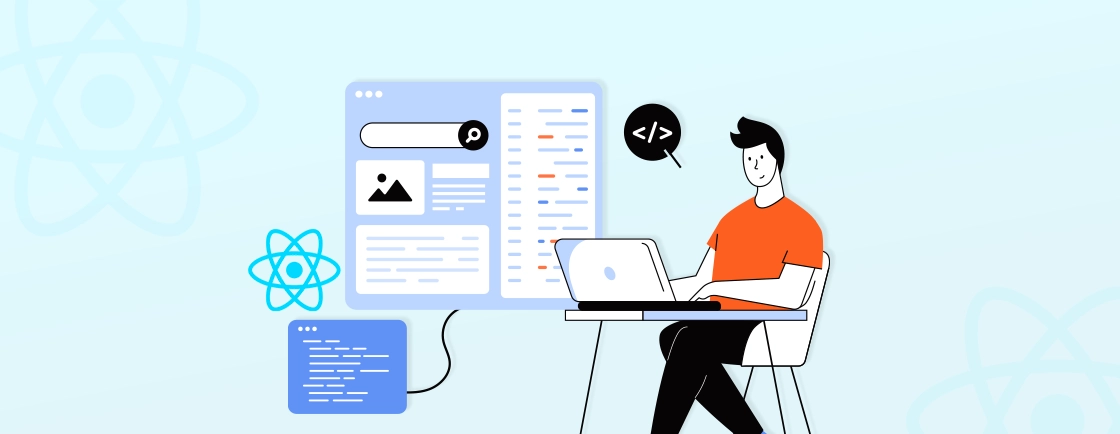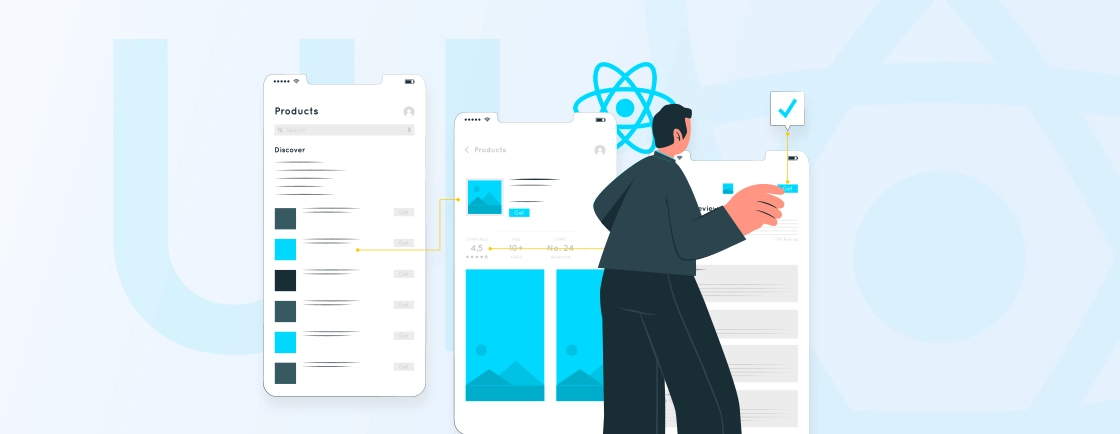Table of Contents
A key part of mobile app development is creating engaging, fluid animations and polished UI components. It can make or break a mobile app’s user experience. For that, you will need the right React Native libraries as they save development time while enhancing usability.
There are libraries like Reanimated and Lottie along with versatile UI component kits like NativeBase and React Native Elements. These tools can help optimize the app for smooth performance and craft visually-stunning interfaces.
In this blog, I’ll list the React Native animation libraries and UI components and their features to make the selection easier for you. You’ll also see the best practices followed by our React Native experts to elevate the mobile app projects.
What are React Native Animation Libraries?
React Native animation libraries, as the name suggests, help create smooth, performant animations in mobile apps. That too, without writing complex code from scratch. These libraries simplify tasks like transitions, gestures, and dynamic effects. That enhances user experience while optimizing performance.
These libraries are for when you need micro-interactions, loading animations, or advanced UI motion. They are tailored for React Native’s cross-platform environment, promoting operational efficiency.
What are React Native UI Components?
React Native UI components are reusable, pre-built design elements. They help assemble polished mobile interfaces without designing everything from scratch. These include components like buttons, navigation bars, cards, and modals. They follow platform-specific design guidelines (iOS and Android) while maintaining a consistent codebase.
UI component libraries like NativeBase can handle styling, responsiveness, and accessibility. So developers can focus on functionality rather than reinventing basic UI elements. It can accelerate development, ensure design consistency, and deliver professional-grade apps.
Top React Native Animation Libraries and UI Components
Creating engaging mobile apps requires smooth animations and polished UI components. To that, React Native has several powerful libraries that can make things easier. Let’s discuss them.
Animation Libraries
1. React Native Animatable
GitHub Stars: 9.9k Stars
React Native Animatable simplifies animation implementation with a declarative API, offering pre-built transitions like fades, slides, and bounces. Its strength lies in ease of use—just wrap components and apply animation names.
Developers love it for quick prototyping, but it’s also robust enough for production. Since it uses the native animation driver, performance remains smooth. Ideal for entry-level animations, it’s a go-to for adding subtle motion effects without heavy dependencies.
Key Features
- Pre-built animations (fade, slide, bounce, etc.)
- Simple declarative API (just name the animation)
- Optimized performance via native driver
- Easy integration (wrap any component)
- Customizable timing & delays
2. Fluid Transitions for React Navigation
GitHub Stars: 2.9k Stars
This library elevates React Navigation with seamless, physics-based transitions between screens. Unlike standard navigation animations, Fluid Transitions enables dynamic shared-element effects and interpolated movements, making app flows feel intuitive.
It’s particularly useful for apps prioritizing UX polish, like e-commerce or social platforms. The declarative syntax integrates effortlessly with existing navigation setups. That means a professional look without complex imperative code.
Key Features
- Smooth screen transitions with shared elements
- Physics-based animations (springs, easing)
- Works with React Navigation (v4 & v5)
- Declarative syntax for easy implementation
- Supports interpolations for dynamic effects
3. React Native Shared Elements
GitHub Stars: 2.3k Stars
Perfect for crafting Pinterest-like transitions, this library animates elements seamlessly between screens (e.g., expanding an image into a detailed view). It works with React Navigation and supports advanced interpolation, opacity, and transform animations.
Performance is optimized via native threading, avoiding JS bridge lag. A must-have for apps where visual continuity enhances user engagement, such as galleries or travel platforms.
Key Features
- Seamless element transitions between screens
- High-performance (native-threaded)
- Works with React Navigation
- Supports transforms, opacity, & clipping
4. Lottie
GitHub Stars: 16.9k Stars
Lottie brings Adobe After Effects animations to React Native via JSON files, enabling intricate, designer-crafted motion without taxing performance. From playful loaders to interactive onboarding flows, it bridges the gap between design and development.
The library parses vector animations smoothly, even at high frame rates. Brands like Airbnb and Google use Lottie to maintain consistency across platforms while keeping bundle sizes small.
Key Features
- Renders Adobe After Effects animations (via JSON)
- Silky-smooth vector animations
- Small file sizes
- Play/pause, speed control, and looping
5. React Native Redash
GitHub Stars: 2k Stars
Redash is a utility toolkit for gesture-driven animations, offering math helpers, animation primitives, and gesture-composability. It’s the backbone of complex interactions—think swipeable cards or dynamic draggable elements.
Built with Reanimated v2, it leverages native threads for buttery-smooth results. Ideal for developers who want fine-grained control over physics-based animations without reinventing the wheel.
Key Features
- Gesture-driven animation utilities
- Math helpers for physics-based motion
- Built for Reanimated v2 (high performance)
- Composable gestures (swipes, drags, pans)
6. React Native SVG Animations
GitHub Stars: 179 Stars
This library combines SVG’s scalability with declarative animations, perfect for data visualizations, custom loaders, or branded motion graphics. It supports path morphing, stroke animations, and coordinate transitions, all renderable at 60 FPS.
Since SVGs are resolution-independent, animations look crisp on any device. A niche but powerful choice for apps needing bespoke animated illustrations.
Key Features
- Animate SVG paths & shapes
- Supports stroke animations & morphing
- 60 FPS performance
- Resolution-independent (crisp on any screen)
- Great for loaders & data visualizations
7. React Native GL Models View
GitHub Stars: 420 Stars
For 3D animations, this OpenGL-powered library renders textured models with smooth rotations, zooms, and transitions. It’s a game-changer for AR previews, product configurators, or educational apps requiring 3D manipulation.
While setup is more involved than 2D alternatives, the visual payoff is unmatched. Supports .obj files and integrates with gesture handlers for interactive models.
Key Features
- 3D model rendering (OBJ files)
- OpenGL-powered animations
- Supports gestures (rotate, zoom, pan)
- Texture & lighting effects
- Ideal for AR previews & product showcases
UI Components
1. NativeBase
GitHub Stars: 20.3k Stars
A comprehensive UI kit with 50+ customizable components (buttons, modals, etc.) following Material and iOS design guidelines. NativeBase accelerates development with responsive layouts, dark mode support, and accessibility baked in.
Its theme system lets teams maintain design consistency across apps. Popular among startups for its balance of flexibility and out-of-the-box functionality.
Key Features
- 50+ customizable UI components
- Cross-platform (iOS/Android styles)
- Theming & dark mode support
- Responsive layouts
2. React Native Maps
GitHub Stars: 15.4k Stars
The de facto mapping solution for React Native, offering Google Maps and Apple Maps integrations with smooth markers, polygons, and camera animations. Ideal for ride-sharing, delivery, or travel apps.
Features like heatmaps and clustering handle large datasets efficiently. Community-driven updates ensure compatibility with the latest OS features.
Key Features
- Google Maps & Apple Maps support
- Smooth markers, polygons, heatmaps
- Camera animations & zoom controls
- Clustering for large datasets
- Community-maintained & updated
3. React Native Camera
GitHub Stars: 9.6k Stars
A robust camera module supporting barcode scanning, face detection, and video recording. Its modular API lets developers implement custom overlays and real-time processing. Used in retail (QR scanners) and social apps (story creation). Though deprecated, community forks like react-native-vision-camera offer modern alternatives with better performance.
Key Features
- Barcode/QR scanning
- Face detection & text recognition
- Photo & video capture
- Customizable overlays
- Legacy support for older apps
4. React Native Elements
GitHub Stars: 25.4k Stars
A cross-platform UI toolkit with pre-styled components (buttons, avatars, search bars) that follow best practices. Its modular design allows mixing and matching styles without bloat.
Theming support ensures brand alignment, while TypeScript types enhance developer experience. A reliable choice for MVPs or apps needing rapid iteration.
Key Features
- Pre-styled UI components (buttons, cards, etc.)
- Cross-platform design
- Theming & customization
- TypeScript support
- Modular & lightweight
5. React Native Snap Carousel
GitHub Stars: 10.5k Stars
A high-performance carousel with gestures, parallax effects, and pagination. Optimized for iOS and Android, it handles thousands of items smoothly.
eCommerce apps use it for product galleries, while news apps leverage it for story sliders. Customizable via props like sliderWidth and itemWidth for pixel-perfect layouts.
Key Features
- Smooth, gesture-driven carousels
- Parallax effects & pagination
- Optimized for performance
- Customizable item layouts
- Great for product galleries & stories
6. Bit for React Native
GitHub Stars: 18.1k Stars
Bit lets teams share and reuse React Native components across projects via a decentralized registry. It tracks component versions, dependencies, and even auto-generates docs.
Ideal for organizations scaling design systems or micro-frontends. Integrates with existing codebases, turning UI elements into collaborative building blocks.
Key Features
- Share & reuse components across projects
- Version control for UI elements
- Auto-generated documentation
- Supports micro-frontends
- Integrates with existing codebases
Each library or component solves specific challenges—whether animation fluidity, UI consistency, or development speed. You need to choose based on what you desire in your mobile app–performance, design fidelity, or time-to-market.
For the best selection and integration, get our React Native app development services.
React Native App Project?
Let’s Summarize
Animation libraries and UI components can transform your React Native app from functional to exceptional. With these, you can implement smooth transitions, gesture-driven interactions, or polished UI elements.
Some of the top libraries include Lottie for animations, NativeBase for ready-made components, React Native Maps for location-based features, etc. The best choice depends on your project needs. Do you prioritize simplicity? Do you need advanced motion? Or maybe you need faster development. There’s a library for everything.
Want to integrate the best libraries to enhance your app’s functionality? Hire React Native app developer to get expert support and build a high-performance mobile solution.
FAQs on React Native Animated Libraries & UI Components
Can I use Lottie for complex animations?
Yes! Lottie renders Adobe After Effects animations (exported as JSON) at 60 FPS, making it ideal for intricate motion graphics, loaders, and interactive UI effects.
Which library is best for gesture-driven animations (e.g., swipeable cards)?
React Native Redash – Works seamlessly with Reanimated 2 to create advanced interactions like drag-and-drop, swipe gestures, and physics-based animations.
How do I animate SVGs in React Native?
React Native SVG Animations – Let’s you animate paths, strokes, and shapes smoothly. Perfect for custom loaders, data visualizations, and dynamic icons.
Is there a React Native library for 3D animations?
React Native GL Model View – Renders 3D models (OBJ files) with OpenGL, supporting rotations, zooms, and gestures. Ideal for product showcases or AR-like experiences.
Which library is best for maps?
React Native Maps – The go-to solution for Google/Apple Maps integration, with markers, clustering, and smooth camera movements.
Build Cross-Platform React Native Apps
Discover how to create cross-platform mobile applications using React Native.





